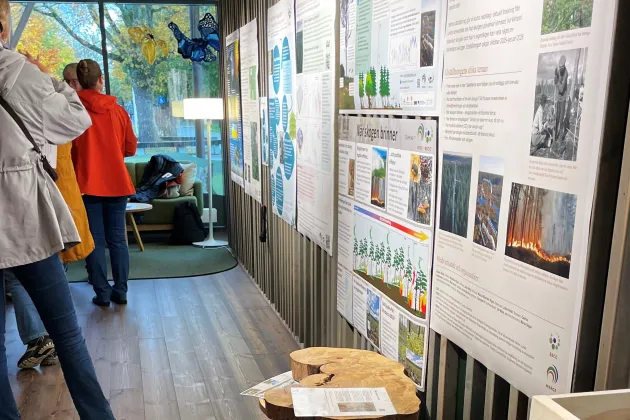Oct
Climate and Forests – Popular Science Exhibition at Naturum Skrylle

Curious about how forests affect the climate, how the climate affects forests, and how we can actually know anything about the forests of the future? Then this exhibition at Naturum Skrylle is for you!
Forests play a crucial role for people, the climate, and biodiversity – a topic that is increasingly discussed in society. In this exhibition, we highlight current research from Lund University that explores this highly relevant subject through brief insights into different scientific perspectives.
Popular science posters and film
At research conferences, scientists often present their latest findings using scientific posters. We’re now bringing this concept to Skrylle – in a more accessible format. Several researchers have created popular science posters that explore the relationship between forests and climate from different perspectives:
- Seeing More from Above: Satellites that help us map and monitor our forests.
- What Does the Future Hold for Our Forests? Predicting the consequences of climate change and forest management.
- When the Forest Burns: Wildfires in a changing climate.
- In the Mind of a Forest Owner. Ideas about the forest, from past to present.
- How Much Carbon Dioxide (CO₂) Does the Forest Absorb?
- Biodiversity Gives Forests Resilience in a Changing Climate
- Film: Klimatmodeller och Skogen (only in Swedish)
In addition to the posters, a short film is also shown, produced in collaboration between Lund Municipality and the strategic research area MERGE* based at Lund University. The film offers insight into how researchers use climate models to study the forest’s role in the climate system – and how this research can contribute to important decisions made by, among others, the UN’s climate panel, the IPCC.
Click through to Naturum Skrylle’s website for more information: Skrylle – motion och friluftsliv
Organisers and participating reserachers
The exhibition is a collaboration between Naturum Skrylle, the municipality pf Lund and the strategic research areas BECC** and MERGE. Participating researchers from Lund university are:
- Hakim Abdi, researcher at Centre for Environmental and Climate Science and BECC
- Researchers behind the dynamic global vegetation model (DGVM): LPJ-GUESS
- Natascha Kljun, professor at Centre for Environmental and Climate Science and researcher BECC/MERGE
- Julia Kelly, researcher at Centre for Environmental and Climate Science and BECC
- Hanna Ekström Pigot, doctoral student at Centre for Environmental and Climate Science and BECC.
- Jutta Holst, researcher at ICOS Sweden and BECC.
- Cecilia Akselsson, professor Dept of Physical Geography and Ecosystem Science and researcher BECC/MERGE.
- Moa Sporre, researcher Combustion Physics and MERGE.
- David Wårlind, researcher Dept of Physical Geography and Ecosystem Science and researcher BECC/MERGE.
*The strategic research area ModElling the Regional and Global Earth system (MERGE) is a research environment hosted by CEC. It engages about 250 researchers at Lund University, University of Gothenburg, Rossby Centre/SMHI, Chalmers University of Technology and Royal Institute of Technology. Learn more about MERGE on the website: MERGE Startpage | MERGE
**BECC (Biodiversity and Ecosystem services in a Changing Climate) is a strategic research area, funded by the Swedish government, that engages about 350 researchers at Lund University and the University of Gothenburg. BECC brings together scientists from the natural and social sciences with the aim to provide a scientific basis for the sustainable management of ecosystems and biodiversity.: www.becc.lu.se
About the event
Location:
Naturum Skrylle
Admission:
Free admission
Target group:
Open to everybody
Language:
Swedish and English
Contact:
therese [dot] ek [at] cec [dot] lu [dot] se

